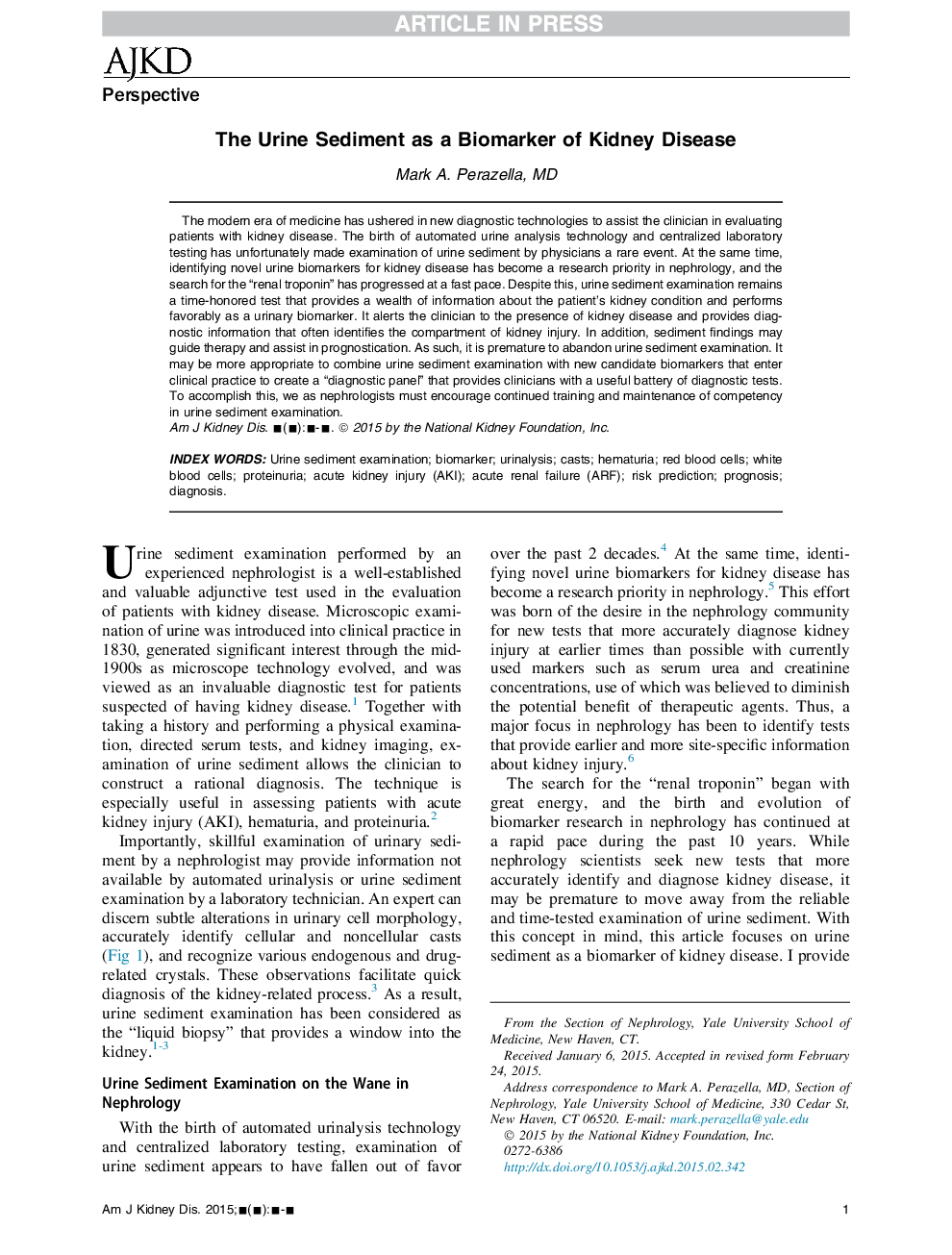| کد مقاله | کد نشریه | سال انتشار | مقاله انگلیسی | نسخه تمام متن |
|---|---|---|---|---|
| 3847443 | 1598248 | 2015 | 8 صفحه PDF | دانلود رایگان |
عنوان انگلیسی مقاله ISI
The Urine Sediment as a Biomarker of Kidney Disease
ترجمه فارسی عنوان
رسوبات ادراری به عنوان بیومارکر بیماری کلیه
دانلود مقاله + سفارش ترجمه
دانلود مقاله ISI انگلیسی
رایگان برای ایرانیان
کلمات کلیدی
CASTSRed blood cells - سلولهای قرمز خونUrinalysis - آزمایش ادرارacute kidney injury (AKI) - آسیب حاد کلیه (AKI)Biomarker - بیومارکرDiagnosis - تشخیصAcute renal failure (ARF) - نارسایی حاد کلیه (ARF)Hematuria - هماتوریا یا هماچوری یا خون ادرارProteinuria - پروتئینوریRisk prediction - پیش بینی ریسکprognosis - پیش شناخت بیماریwhite blood cells - گلبول های سفید خون
ترجمه چکیده
دوران مدرن پزشکی در فن آوری های تشخیصی جدید برای کمک به پزشک در ارزیابی بیماران مبتلا به بیماری های کلیوی پیش رفته است. متاسفانه تولد تکنیک تجزیه و تحلیل خودکار ادرار و تست آزمایشگاهی متمرکز، یک آزمایش نادرست برای بررسی رسوب ادرار توسط پزشکان است. در عین حال شناسایی جدیدی از نشانگرهای ادرار برای بیماری کلیوی، به عنوان اولویت پژوهشی در بیماری های نفرولوژی و جستجو برای تروپونینای ریه تبدیل شده است. با پیشرفت سریع پیشرفت کرده است. با وجود این، معاینه رسوب ادرار همچنان یک آزمایش محرمانه است که اطلاعات فراوانی در مورد وضعیت کلی کلیه بیمار ارائه می کند و به عنوان یک نشانگر بیولوژیک ادراری مناسب است. این پزشک به علت بیماری کلیوی هشدار می دهد و اطالعات تشخیصی را که اغلب قسمت مجروحیت کلیه را مشخص می کند، فراهم می کند. علاوه بر این، یافته های رسوب می تواند درمان را هدایت کند و در پیش بینی بیماری کمک کند. به این ترتیب معاینه رسوب ادرار دیررس است. ممکن است مناسب تر باشد که معاینه رسوب ادرار را با زیست سنجی های جدید نامزد جایگزین کنید که برای ایجاد پانلا تشخیصی وارد عمل بالینی می شوند؟ که پزشکان را با یک باتری مفید از آزمایش های تشخیصی فراهم می کند. برای انجام این کار، ما به عنوان نفرولوژیست ها باید آموزش مداوم و حفظ صلاحیت در آزمایش رسوب ادرار را تشویق کنیم.
موضوعات مرتبط
علوم پزشکی و سلامت
پزشکی و دندانپزشکی
بیماریهای کلیوی
چکیده انگلیسی
The modern era of medicine has ushered in new diagnostic technologies to assist the clinician in evaluating patients with kidney disease. The birth of automated urine analysis technology and centralized laboratory testing has unfortunately made examination of urine sediment by physicians a rare event. At the same time, identifying novel urine biomarkers for kidney disease has become a research priority in nephrology, and the search for the “renal troponin” has progressed at a fast pace. Despite this, urine sediment examination remains a time-honored test that provides a wealth of information about the patient's kidney condition and performs favorably as a urinary biomarker. It alerts the clinician to the presence of kidney disease and provides diagnostic information that often identifies the compartment of kidney injury. In addition, sediment findings may guide therapy and assist in prognostication. As such, it is premature to abandon urine sediment examination. It may be more appropriate to combine urine sediment examination with new candidate biomarkers that enter clinical practice to create a “diagnostic panel” that provides clinicians with a useful battery of diagnostic tests. To accomplish this, we as nephrologists must encourage continued training and maintenance of competency in urine sediment examination.
ناشر
Database: Elsevier - ScienceDirect (ساینس دایرکت)
Journal: American Journal of Kidney Diseases - Volume 66, Issue 5, November 2015, Pages 748-755
Journal: American Journal of Kidney Diseases - Volume 66, Issue 5, November 2015, Pages 748-755
نویسندگان
Mark A. MD,
